Editor’s Note: Milton Knight returns to Cartoon Research today to shed light on one of his favorite comic book series and its artist creator, Dan Gordon – an animator who deserves more credit than he’s gotten, for his significant contributions to the art. Milton himself is one of leading historians of classic “funny animal” comics and I hope this post will lead to others which will enlighten us about other unsung comic book artists of the 1940s and 50s. Milton Knight is also one of the great artists of the current day – to enjoy more of Milton’s thoughts, his comic art and his paintings, I urge you to visit his blog, The World Of Knight, and his art site, miltonknight.net. – Jerry Beck

Fred Iger, business manager of the American Comics Group, had no idea what I was talking about when I brought up the term “funny animal” comics.
When they were going strong, “funny animal” comics were called “animation” comics within the industry. They were created to directly compete with WALT DISNEY’S COMICS AND STORIES and the LOONEY TUNES magazine. Without these books blazing the trail, the genre would never have materialized. Yes, it was pure opportunism. But some worthy art was created. It is quite possible that the genre declined in the 1950s because television came into the home to “bring the movies to you”, to quote a Timely/Marvel promotion. (And now, the home video market has made it just about superfluous.)
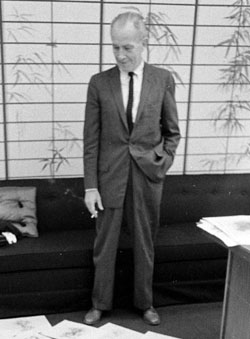
Dan Gordon at Hanna Barbera in the early 1960s.
Gordon’s comics for ACG, including SUPERKATT, COOKIE, PUSS ‘N’ BOOTS and BLUNDERBUNNY, were written in partnership with Richard E. Hughes, editor, and a brilliant comics writer in his own right, later creator of Herbie, The Fat Fury.
Without a stable of established film characters to draw from, most of the early magazines were patchwork quilts of one-shot strips destined to be forgotten by readers and history. Gordon began in the spectrum of ACG and Pines magazines drawing starless strips such as “Fish a’la Brooklyn” and “Gregory, the Rogue”. It wasn’t until the ninth issue of GIGGLE (June 1944) that SUPERKATT was born.
Who… or what was this weird presence swaddled in Baby Huey bonnet and diapers which obscured that he was even a cat? SUPERMOUSE had already turned out to be a popular commodity in COO COO Comics, and in imitation of Fawcett’s HOPPY THE MARVEL BUNNY, Timely/Marvel had added SUPER RABBIT to its roster. Plus, of course, the early version of Mighty Mouse (originally called SUPER MOUSE) was lighting up the cinema screen. The name Superkatt suggests another beast with the same gimmick, but Gordon (who had directed some of the Famous Studios’ SUPERMAN cartoons) indulged his quirky mind. The hero was a mere house cat (called only “dat katt” by the housekeeper) who ineptly strove to imitate the superbeings of the comic books. In his tale of origin, rats and birds duped him into believing he had powers of strength and flight, thus distracting him from his pursuits. It wasn’t long before the origin was forgotten, and the Katt was “Super” by virtue of being a sanctimonious, self-proclaimed “force for good” – similar to the dreaded Gabby, know-it-all protagonist of Fleischer’s Gulliver’s Travels, in which Gordon had a hand.All the characters were painted in broad and sometimes offensive strokes. Presiding over Superkatt’s mysteriously truncated “family” was Petunia Washington, a “colored” maid of the most stereotypical type. The series began with her as a broom-wielding monster, ugly and threatening even by comic art standards. The reason I feel I can cut Gordon some slack here is that, in the later forties – parallel to “Ebony White” in Will Eisner’s The Spirit – some efforts were made to soften the character, making her less offputting but still clown-like in appearance, capable of compassion, and even the rare romantic interest.
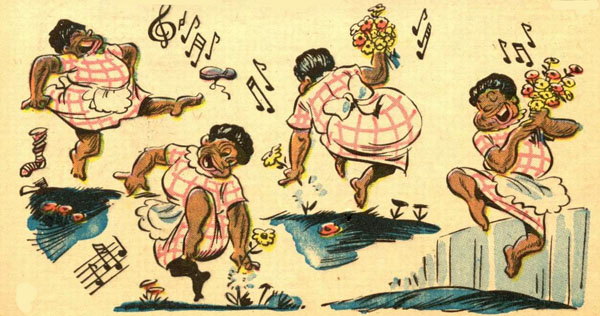
Completing the household picture was Junior, a “mean widdle kid” who cruelly targeted “de katt” with his dynamite and popguns. This pretty much sums up his function.
Superkatt’s biggest booster was Humphrey, a “dumb dawg” with a golden heart who firmly believed in the katt’s superior powers, and kowtowed accordingly as his hero battled various terrorists of the back alleys, with Evil-Eye the Rat leading a pack of derby-hatted, cigar smoking miscreants with names like Grogan, Itchy, Hoiman and Oiving.Approaching the subject today, long after the flush of pre-adolescence, I wish I could tell you I feel the stories were classics through and through. The mostly featherweight plottings were hooks on which Gordon hung his eye-catching drawings and pungent humor. Like the Warner cartoons, Gordon’s tales, with their rich characterizations and snappy, believable dialogue, had much in common with radio humor, and Gordon comes close to being the Fred Allen of comic books.
SUPERKATT was at its best when thumbing its nose at ordeals familiar to children: dread of school, familial turmoil, overbearing authority. In a memorable story, the Mayor outlaws bubble gum (a post-war craze), to the extent of imprisoning children, until Superkatt challenges his iron hand (“Wait! I revoke the law! Turn all the kiddies free!”). In Christmas stories, Superkatt suspected Santa Claus of being a superforce for evil, picturing him as a mad scientist or a warmonger caressing an A-bomb. The comic clearly went in directions that no Dell comic ever would. (click-to-enlarge selected pages embed below to view some of Gordon’s work).
A popular feature in GIGGLE, Superkatt enjoyed a good, long run, ending in the early 1950s. Dan Gordon’s art became rougher and more functional as time passed, but the strip’s humor actually continued to sharpen. Toward the end, ACG artists Lynn Karp and Ken Hultgren occasionally filled in. Fred Iger recalled that Gordon left the comic book arena in the early 1950s, and when Superkatt left GIGGLE, his star position was supplanted by longtime regular Spencer Spook, no doubt in convenient competition with a new comics phenomenon, Casper the Friendly Ghost.
Superkatt had little impact outside the magazine. There was no licensing, save for a depressing screen ‘adaptation’ from Screen Gems, Leave Us Chase It (May 1947). Strangely, the credits make no mention of GIGGLE comics or American Comics Group. (see embed below).

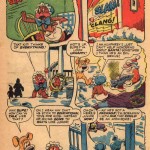
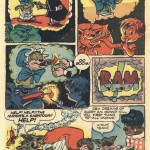

Today, the character of Superkatt is remembered by very few… but remembered very fondly.
Included below are links to three stories from the series’ peak year, 1948. We thank the source of our links and illustrations, Comic Book +, a splendid site with scans of every type of comic. Enjoy!




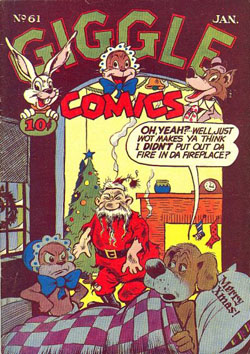
 Milton Knight is an artist of wide experience, having been involved in comics, illustration, animation and painting. You’ve seen his animation in Sonic The Hedgehog, The Twisted Tales of Felix The Cat and in Ralph Bakshi’s Cool World. His comic art has graced Mighty Mouse, Teenage Mutant Ninja Turtles and his own book, Hugo. Knight has also recently completed his first novel. Visit his blog at
Milton Knight is an artist of wide experience, having been involved in comics, illustration, animation and painting. You’ve seen his animation in Sonic The Hedgehog, The Twisted Tales of Felix The Cat and in Ralph Bakshi’s Cool World. His comic art has graced Mighty Mouse, Teenage Mutant Ninja Turtles and his own book, Hugo. Knight has also recently completed his first novel. Visit his blog at 











































Ahhhh-
Good to see Knight back in.
I liked Petunia, the Black maid! She may have been a stereotype, but she had personality. In fact, she had so much attitude that I wondered who was the real boss in that household? Her supposed employers, the White Junior’s parents, were never shown. As a preadolescent kid, I couldn’t imagine her taking orders from anybody!
Hmmm! There was also an anti-bubblegum story about the same time in the funny-animal “Hi-Jinx Comics”, also published by ACG, written by Cal Howard (also an ex-animator) and drawn by Jack Bradbury. Coincidence? I think not.
I read somewhere that Dan Gordon wrote & drew “Superkatt” for “Giggle Comics” until he was recruited by Joe Barbera for the new Hanna-Barbera studio. I was skeptical of that because “Superkatt” (never mind “Giggle Comics”) disappeared a couple of years before H-B appeared on TV. But since the animation studio must have gotten started some time before its first TV cartoons became popular, maybe so.
Fred Iger of ACG remembered that Gordon left for the Midwest in the early 1950s. One may assume he was dealing with some personal turmoil before going West. (His son had also died in a fire, but I don’t know when.)
Thanks, Milton! I can remember as a kid reading Superkatt and Super Duck and always wondering what was so “super” about them.
Was that puzzle page (“READ SUPERKATT AND WATCH FOR HIM IN THE MOVIES”) the only time the comic book told their readers about the Screen Gems adaptation? It feels like the two companies tried their darndest to distance themselves from each other.
I’m happy to read these comic book histories on this site. Keep ’em coming, Milton!
A perceptive and compelling study. I wish the article were longer, which is a compliment.
Animation buffs should be aware that Dan Gordon was the actual, if unacknowledged creator of The Flintstones — a fact that Joe Barbera would take with him to his grave. Gordon was a superbly talented cartoonist and story-teller, who — unfortunately — was also a raging alcoholic, which ultimately claimed his life in a home fire, while in a booze-filled stupor.
I will never forget attending a press event at Hanna-Barbera back in 1990. It was to celebrate the Flintstones 30th anniversary. When it came time for Bill and Joe to speak to the cameras, Joe was being Joe. But when Bill spoke he started thanking people, specifically Ed Benedict for designing the characters, Warren Foster for writing the bulk of the first season stories, and Dan Gordon for coming up with the idea. Joe looked completely caught off guard because Bill was crediting other artists, but quickly recovered, saying, “Oh, yeah. Those guys were great, too.”
That’s sad to read.
Is it em, or does Superkatt look like a Dr. Seuss character?
Oh, and there were no credits on “Leave Us Chase it” because it was a print from Totally Tooned In! There were credits on it originally.
I would assume that as well, there must be some sort of tiny print somewhere in the credits about it if possible, I just haven’t seen it.
I am pretty sure I saw the full print when the film was acquired and there were no publication credits. But my memory could be playing tricks. I’ve sent out some feelers, and hope to tell you fer sure soon.
Jerry Beck also recalls no credit to comic, cartoonist or publisher.
Is it em, or does Superkatt look like a Dr. Seuss character?
It’s uoy. (Sorry, Richard – couldn’t resist) 😀
I just have one question…..was super katt the first ever baby puss….since he wore a diaper,baby bonnet ?
And yet I liked Hultgren’s “Duke & The Dope” more myself.
That is rather odd they wouldn’t at all.
A nifty article, and that Valentine has the marks of true love all over it. Who couldn’t feel loved with Superkatt. I need to visit some of these comics! I really like the cover on the Halloween issue. Thanks!
Thank you, Milton. I loved funny animal comics (including “Funny Animals”) in my early adolescence. Superkatt was one of my top favorites, that and Walt Kelly’s collection of swamp critters. Never thought I’d see Superkatt again. Nice job of research!
Excellent posting!
A terrific, well-written and insightful article, Milton! Thanks very much for throwing some light on this largely forgotten character and the talented hand behind him! I hope you’ll focus on more of the ACG stable in the future!
This sounds really fascinating, but my screenreader isn’t picking up the links to the videos; I always have to open Firefox for that to happen; I wonder how this changed over time and why I can no longer read the link to open the videos. Anyway, I like the concept of SUPER CAT, simply because I’m a cat lover. I always had this cartoon series thought out in my head of a housecat that manages to foil crimes of all kinds. The character is not anthropomorphized and he has no voice, so the challenge to animators would be to “mime” thet attitudes, similar to the earliest TOM AND JERRY cartoons. In the end of each adventure, no one can figure out why a crime was thwarted or how, but somehow, this very small and unassuming cat terrorized the villain, animal or human, into leaving the scene of what could have been a crime very quickly…anyway, I’m sure I’ve checked out the cartoon, because I always watched TOTALLY TUNED IN while it was still on the air.
In the super katt comics….he was tricked into taking castor oil,bonked on the head with a mallet and had his wiskers played like a violin…the same thing happened in tom and jerry baby puss….so i was just curious if super katt was the first baby puss.
I was just curious,,,was super katt the very first baby puss? because he reminds me of baby puss.
I know this was posted so so long ago, but I was just trying to read into why Superkatt stopped and found this article. I have flipped through every single Giggle comic and fell in love with the Superkatt comic. It was so sad when it just stopped being included, but you could see the changes in the last few of its publications. It was fantastic. I love Spencer Spook as well, but I have to profess my love for the one and only Superkatt!